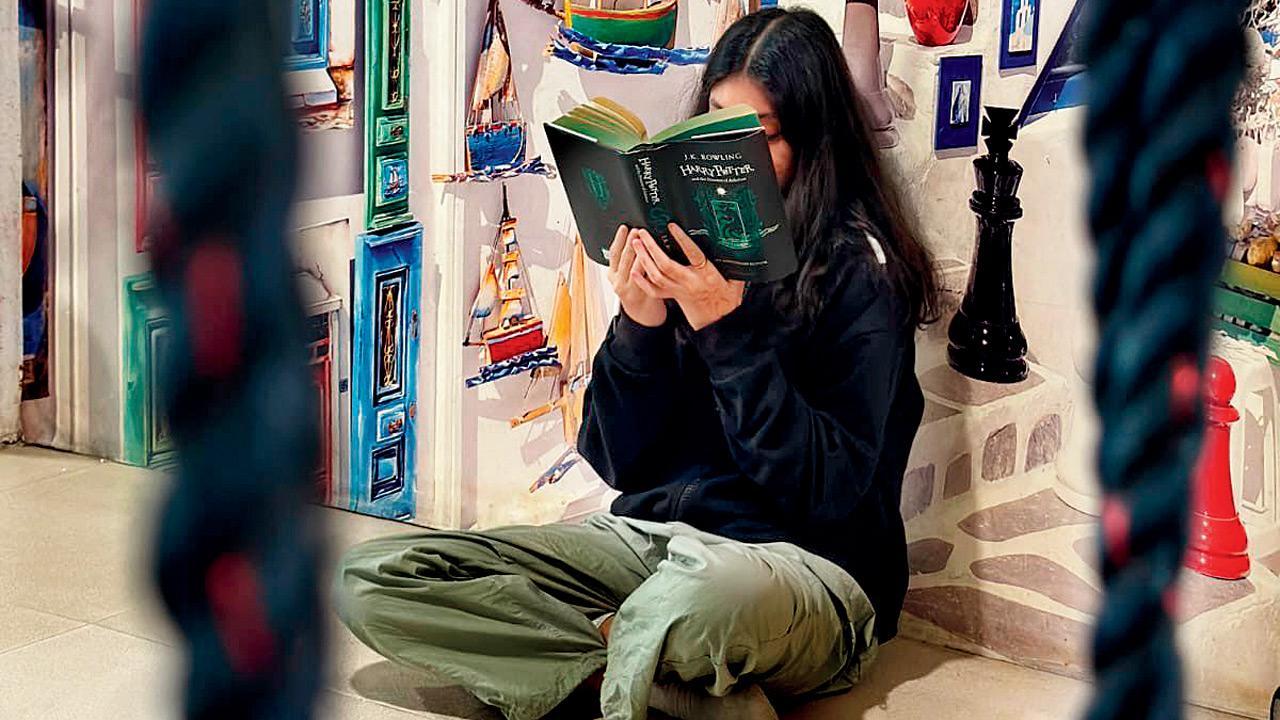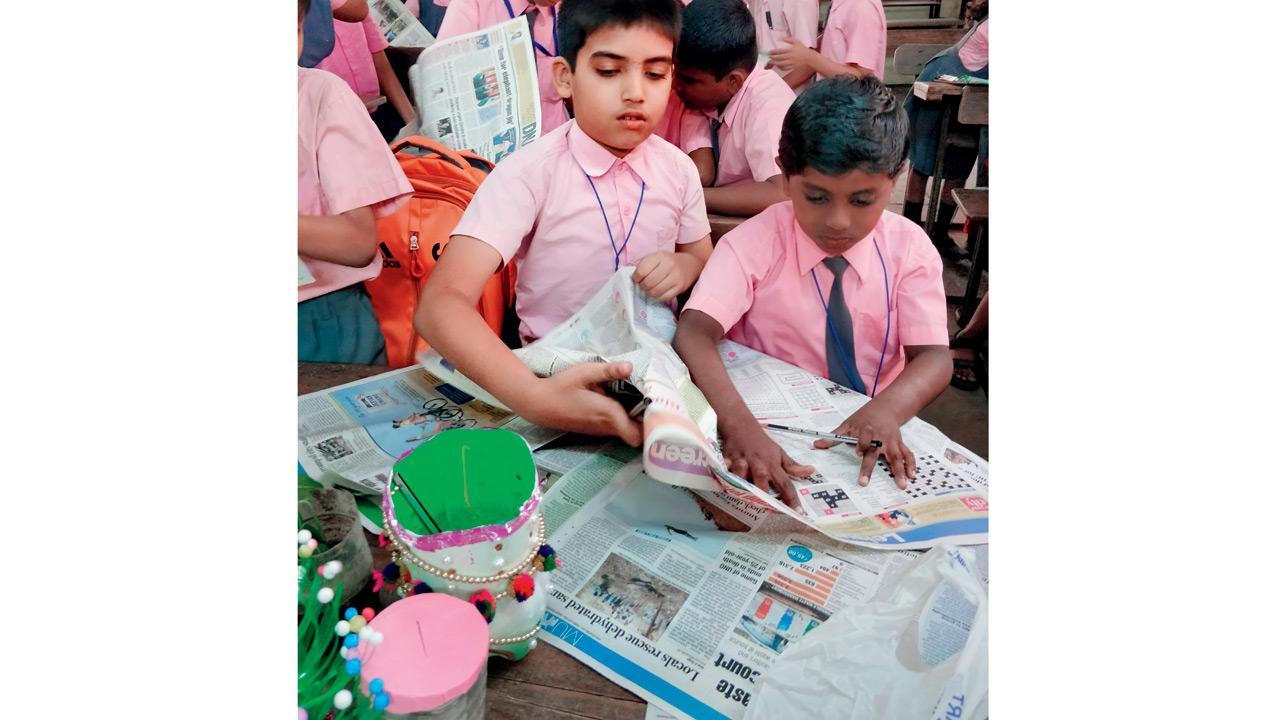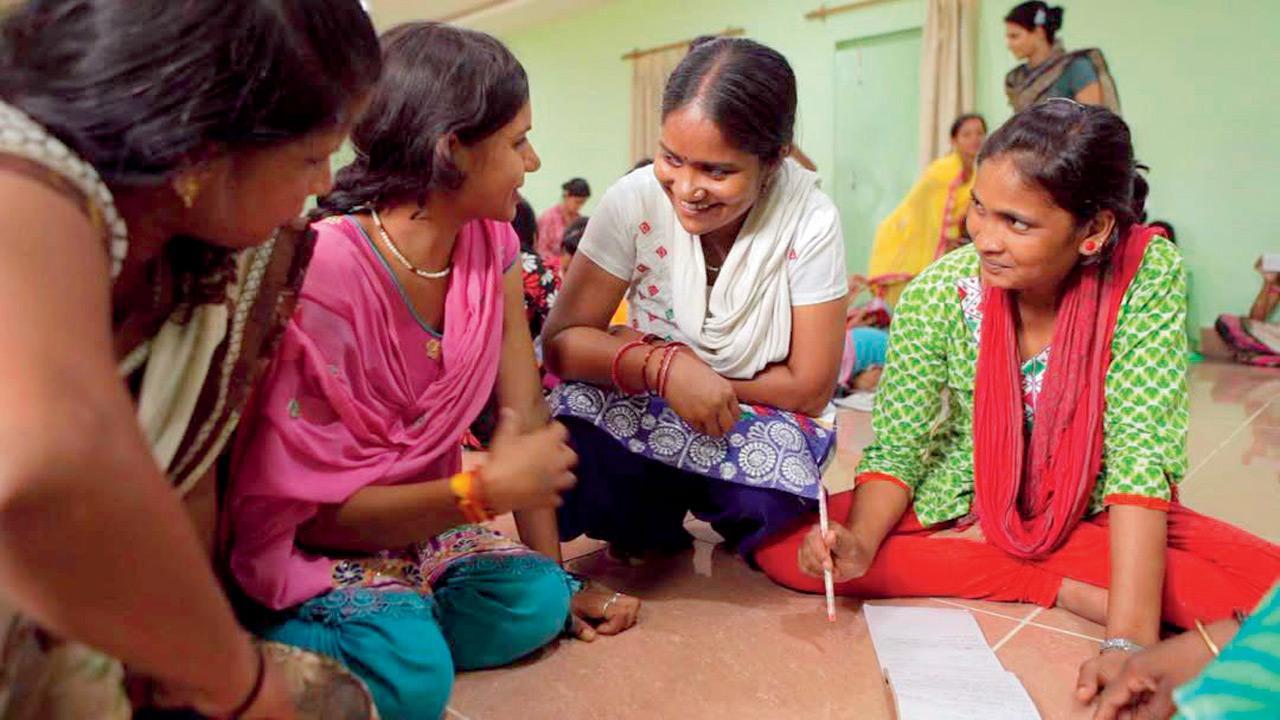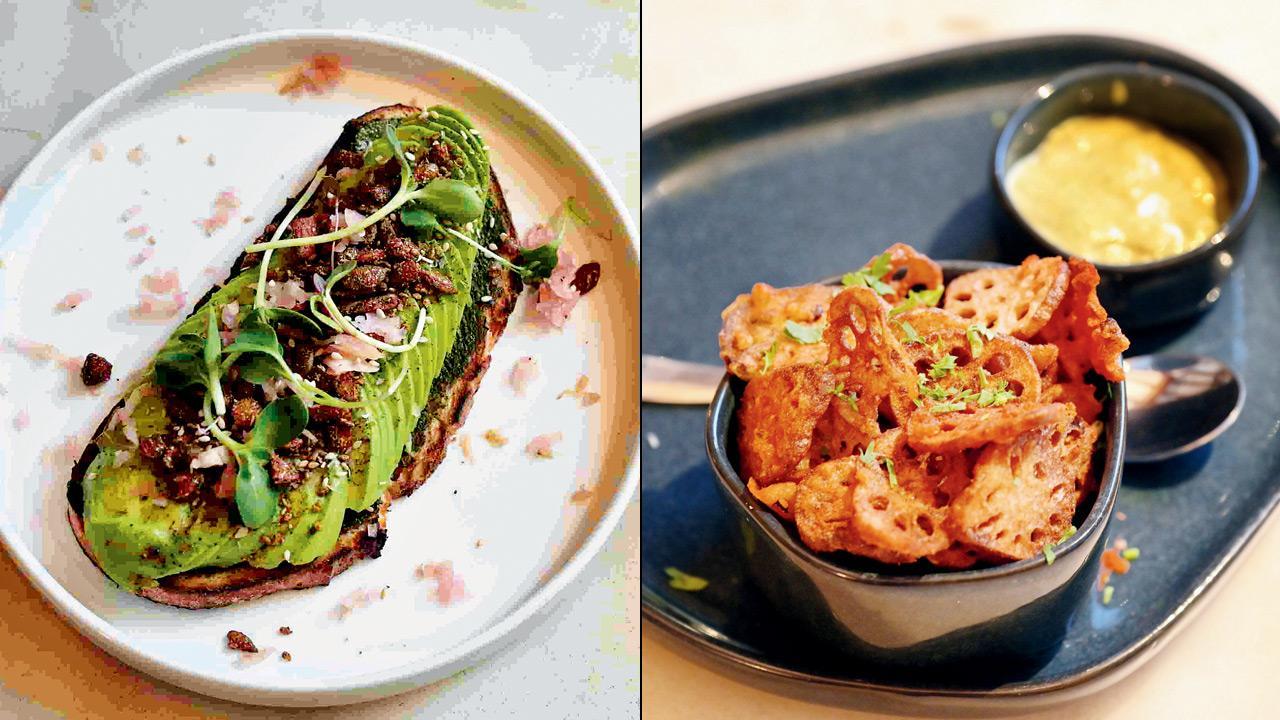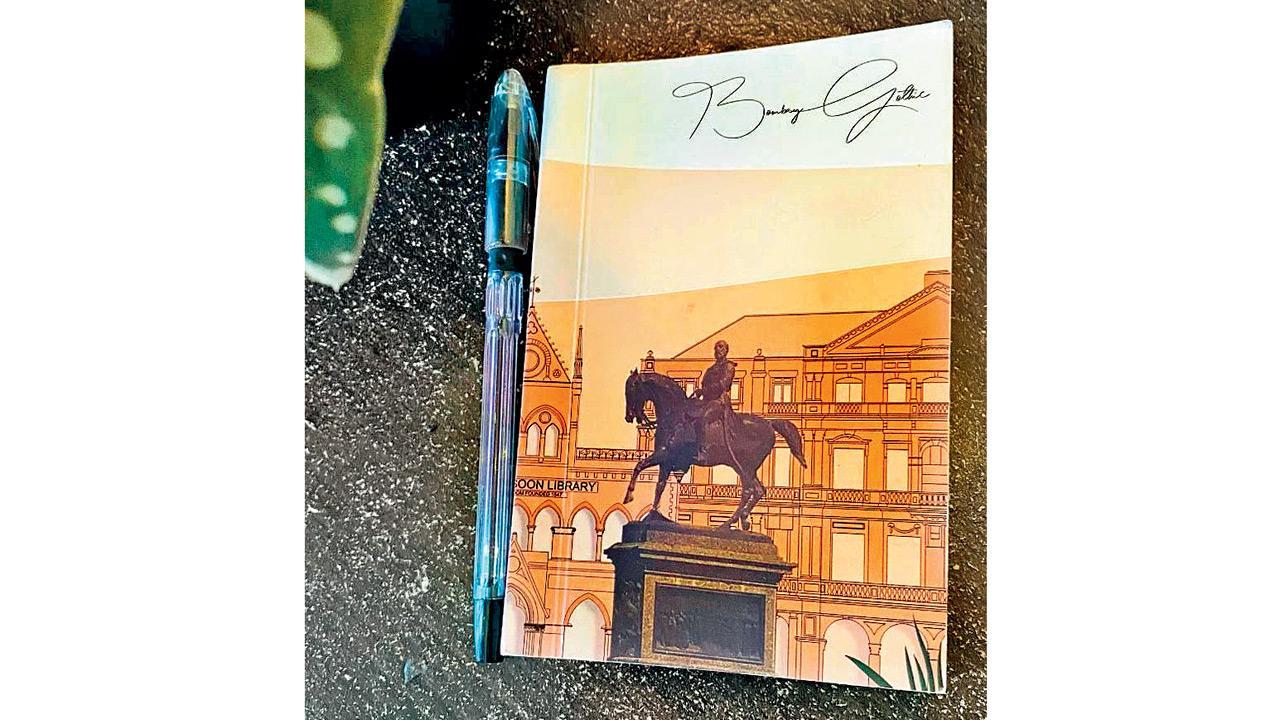Read Things To Do News
Want to start gardening in your home? Attend this workshop to learn more
Be honest. Haven’t you at some point fantasised about ditching the city’s chaos and escaping to a peaceful countryside home where you grow your own little herbs and fresh juicy tomatoes? We certainly have. But as it turns out, even if that far-off dream were to come true, most Mumbaikars would be left clueless. Dsouza’s vertical plant wall. PICS COURTESY/Clyde Dsouza Nurturing a garden is a far more mindful process than you’d think. Green Chimes, a community venture, hosted their first balcony gardening workshop at a Santacruz nursery last week to teach Mumbaikars the basics of building a home garden. Let there be light Plants that are marketed as low-maintenance and dark room-friendly are shady business, says Clyde Dsouza, horticulture consultant. “No plant can grow in your bathroom shielded from sunlight for your convenience. Sunlight is central to photosynthesis,” he clarifies. Potted monstera and snake plants in Dsouza’s balcony To choose the right plant for your home garden, he offers a simple guide. If your window lets in six to seven hours of sunlight each day, you’re in luck; you can grow most plants with ease. Flowering varieties like hibiscus, mogra, and jasmine need around six hours of sunlight to flourish. “Trying to grow a flowering plant without that much light is a waste of money,” he says. Ornamental plants like monstera and snake plant are more forgiving, needing only about three hours of sunlight. As for those fragrant herbs like mint, thyme, and coriander that you can almost catch a whiff of as you read this, they ideally need four hours of light to thrive. Water woes “People think water is some magical elixir; the more, the better. But in reality, the secret is to under-water your plants. Plants actually thrive under a bit of stress,” he reveals. Additionally, he suggests you water your plants during the day, and not as an afterthought before going to bed. “Watering your plants in the absence of sunlight stunts evaporation, leaving your soil sticky and prone to fungal growth,” Dsouza suggests. Participants ready the soil at the pilot workshop in Santacruz In addition to correct drainage, additions like osmocote, cocopeat, and riversand (all available in leading e-stores) can help control the soil conditions for optimal growth, we learn. At the workshops, Dsouza offers a hands-on experience of these techniques. Space jam Robert Fernandes, landscape consultant, admits that having a balcony in this city of matchbox homes is a luxury in itself. “But there are plenty of ways to work around that. You can set up vertical garden walls or use layered horizontal shelves,” he suggests. Dsouza, who is nurturing a 50-sq ft garden in his own home, stands by the advice. “It’s all about mixing it up. For instance, a tall flowering plant placed next to a herb can provide it enough shade to get the right amount of sunlight. When you hit the sweet spot, there’s nothing like it. My home feels cooler on summer days, I can breathe easier and every once in a while, a sunbird comes visiting,” he chuckles. With the pilot workshop receiving an enthusiastic response, the organisation is now planning more sessions in the near future. “We had everyone from retired doctors to young students drop by,” says organiser Aditi Jayakar Kane, adding, “That’s the great part about gardening. Anyone can try their hand at it.” A green thumb, as always, is a bonus. LOG ON TO Green Chimes on Facebook (for updates)
12 April,2025 10:18 AM IST | Mumbai | Devashish KambleHere's how you can enjoy reading books by the pool in Mulund this summer
For all you book lovers out there, a trip to read a book by the beach in this heat might be a far-off dream. How about a literary conversation by the pool instead? Put your reading glasses on, and join The Float House Book Club in Mulund. This indoor pool, event and community space in the eastern suburb is open to all book lovers, aged eight and above, to be a part of engaging literary conversations and finding your own group of bibliophiles. The Float House, which hosts swim, aqua exercise and dive sessions, also has a studio and is celebrating its fifth anniversary this year. The club has been started by young Tejal Ahuja, who also handles the front desk at the space. “The idea is to choose a book and meet every Sunday to discuss, analyse and dive into what we have read all week. We are happy to include children who read or co-read, accompanied by adults, and the session will be moderated to include them,” she says. Ahuja, a psychology graduate will also conduct a case study analysis and discussion of a character chosen by club members. She is currently using the space’s Instagram handle to reach out to readers from the ’burbs, and hopes there will be enough members soon to get this club by the pool going. TIME Sundays; 10 am to 11.30 amAT The Float House, Asha Nagar, Mulund West.CALL 9324666209 ENTRY Rs 500 (membership fee)
12 April,2025 10:13 AM IST | Mumbai | Dhara Vora SabhnaniThink it up: Engage your children in this unique workshop that tests them
If we ask you to come up with a way to eat noodles without using a fork, what will you do? And don’t give us the looks because this question has nothing to do with table manners. On the contrary, it is intended to prod you to think outside the box, or as Butool Abbas tells us, “Test your divergent thinking skills.” This Sunday, a hands-on creative confidence demo workshop conducted by Abbas will pose such fun, quirky and stimulating questions to children along with a host of other activities to mould them in creative confidence. But first, what does the term mean? Children work in groups to create prototypes of their ideas on climate change at the US Consulate General, Mumbai. Pics courtesy/Thinkizm Abbas explains, “Creative confidence is one’s belief in their ability to come up with ideas in any chaotic life situation — and the courage to act on them. Most of us tend to think in a convergent manner which is basically a single solution to whatever problem you are facing. Divergent thinking allows you to view an issue from multiple stand points. It gives you the space to analyse your own ideas and not be biased towards one.” Students from a Santacruz-based school work on a model for cleaner roads in Mumbai Abbas is the founder of Thinkizm Learning Labs, a movement dedicated to creating a culture of thinking that promotes originality and creativity. Her master’s degree in design from IIT Kanpur, and experience of conducting these workshops with children as well as adults has led her to devise innovative strategies to help participants unlearn patterns and work effectively in limited resource environments. A model of a reimagined classroom “The idea is to break assumptions that often stop us from considering alternatives. We will use everyday objects like paper, cardboard and duct tapes as resources for the exercises to make it both simple and invigorating for the children,” the Kanjurmarg resident shares. A detailed prototype of a reconceptualised school Along with discussions, the session will have three major activities; the imagination quest, the curiosity quest and the maker’s quest that will push children to build specific mindsets as they devise methods to approach a problem. The activities will be both individual and group-based with focus on igniting children’s curiosity and discovering their creative potential. “In this day and age when reliance on AI (Artificial Intelligence) and chatbots have increased it is more important than ever to have original thinkers in our society and who better to start with than children,” she tells us before signing off. Butool Abbas ON April 13; 10 am to 12 noonAT Nautilus at Candies, 5AA, Pali Hill, Bandra West.LOG ON TO @thinkizmlearninglabs (to register)COST Rs 200 (for children between 9 to 12 years of age)
12 April,2025 10:06 AM IST | Mumbai | Divyasha PandaConfused about how to pick denims? Follow this easy fashion guide to help you
It feels like just yesterday when barrel jeans were the hottest piece of denim in your wardrobe, before they were unceremoniously dethroned by Kendrick Lamar’s flared swag at the Super Bowl. And now, the Y2K staple, skinny jeans are making the rounds again. If you’re in the market for a new pair, it can seem maddening to settle on one style and make it your own, especially if you’re conscious about being perceived as ‘on trend’ and not a relic from a former fashion cycle. Alaya F styles straight leg jeans. Pic Courtesy/Alaya F on Instagram “I’ve always believed that fashion is truly personal, and the trendiest clothes are those that work best with your personality and body type. This holds especially true in the case of jeans. A good pair of jeans is a wardrobe staple, should last you several years, and should be a pair you reach for without second thought. That’s why, choosing a style that works for you instead of the other way around is crucial,” shares image consultant Greeshma Thampi. Gigi Hadid sports a chic pair of narrow leg jeans. Pic Courtesy/Gigi Hadid on Instagram Chic and sensational Skinny jeans can be a traumatic core memory for many millennials, who’ve had to all but peel off their legging-like jeans after a long day. These days, however, skinny jeans have had a much more comfortable update with slim and straight silhouettes, which hug the legs but also offer some breathing room near your ankles,” explains luxury stylist Meghna Ghodawat. Thampi suggests opting for a mid or high-rise pair if you have a triangular body type, as it will help you to emphasise your wait. Similarly, a high waist on an hourglass body can accentuate the curves. Mid to low rise skinny denims create the illusion of curves on rectangular body types. Bella Hadid in flared jeans. Pic Courtesy/Bella hadid on Instagram Barrelling through With barrel jeans, remember that the silhouette creates curves and draws attention to your waist. It may be the right fit for you if you want to balance your wider hips or thighs with the wider legs of the jeans, or if you are very thin, and want to add the illusion of volume, says Ghodawat. But if you have a very petite frame, this style could easily seem overwhelming. Similarly, if you have an inverted triangle body type, barrel jeans could make you look boxy. To keep your jeans from dating too quickly, choose a pair that is less exaggerated and more streamlined to your body. Exaggerated cuts can add drama to your look. Pic Courtesy/Eve Lily on Instagram Flare it up Flared jeans can work with most body types, depending on how exaggerated or subtle the flare is, Ghodawat says. If you are petite, look for a pair with a minimal flare; taller frames can easily opt for wider flares, which add movement to their look. A mid-rise works beautifully with a shorter torso, while very low-rise styles can be unflattering to diamond body types. It’s also important to consider where the jeans flare out — if you have an hourglass shape, for instance, jeans that hug your thigh and flare out above your knee will accentuate your natural shape and proportions, Thampi signs off. Greeshma Thampi and Meghna Ghodawat Body basics Use the following guidelines to better understand your body type>> A triangle body type has narrower shoulders with broader hips>> If your hips are narrow in comparison to your shoulders, you have an inverted triangle body type>> A diamond body type has a wider midriff>> An angular frame that doesn’t have a defined waistline is described as a rectangular body type>> An hourglass frame has broader and proportional shoulders and hips, with a narrow waist
12 April,2025 09:37 AM IST | Mumbai | Anindita PaulAttend screening of documentary film 'Writing with Fire' in Mumbai
In a world driven by caste and patriarchy, Khabar Lahariya is a news portal that is run by marginalised women of India. Their lives have been chronicled by documentary filmmakers Rintu Thomas and Sushmit Ghosh in their film, Writing With Fire which will be screened at a suburban venue later this week. Rintu Thomas, co-director of the film, talks about what inspired her to film the lives of the reporters of Khabar Lahariya, “When we were invited to meet the reporting team of the news organisation in Uttar Pradesh, we were deeply moved — not just by their journalism, but by the radical act of being themselves in spaces that were never built to hold them. These are marginalised women navigating caste, patriarchy and a digital world, all at once — and doing it with clarity, humour and a sense of purpose. These were themes that aligned with our own interests as filmmakers.” A journalist uses her smartphone camera to research for a story Sushmit Ghosh, the co-director of the film, talks about the problems they dealt with, “The journey was both intense and incredibly rewarding. We spent four years filming with and alongside the journalists, often working in media-dark parts of Uttar Pradesh. In those early years, taking on a long-term project like this came with real financial risks. On ground, there was the obvious challenge of navigating spaces imbued with deep trauma and violence. The risks were real, but so was the clarity of purpose and that’s what carried us through.” (From left) Karan Thapliyal, Sushmit Ghosh, Meera Devi and Rintu Thomas at IDFA Film Festival. Pic Courtesy/ IDFA, Amsterdam Thomas encountered many incidents that touched her. She talks about one such experience, “I remember filming one of the journalists just after she’d interviewed with a sexual abuse survivor. She stepped away, took a breath and immediately shifted to a phone call with her daughter about her tuition fees. That moment — of holding pain, power and care simultaneously — stayed with me. It reminded me why I do this work: to witness and honour that complexity, not simplify it.” The film was screened at multiple festivals like Dharamshala International Film Festival (DIFF) and spaces like Kochi Biennale. Ghosh talks about the awards, “It became the first Indian feature documentary to be nominated for an Academy Award and to win the coveted Peabody Award.” Suneeta (in yellow), one of the journalists, conducts an interview Karan Talwar, co-founder, Harkat Studio, comments about this screening, “We dive deep into journalism or positions of power. Such documentaries are not seen anywhere online. They remain hidden, and so we want to bring them to the surface.” ON April 9; 7.30 pm At Harkat Studio, Bungalow No. 17, Versova, Andheri West. LOG ON TO altshows.comENTRY Rs 150
11 April,2025 04:11 PM IST | Mumbai | Minal SanchetiBandra has a new vegan café and here's all you need to know about it
When we tell you that the newest kid on Bandra’s café scene is a plant-based offering, you could accuse us of stating the obvious. And, perhaps, you’d be right. The hipster suburb has, in recent years, come to be synonymous with bougie eateries that are, perhaps one menu item away from sounding almost too sanctimonious in the earnestness with which they approach the conscious living/clean eating/mindfulness mandate. And so, when we heard about pause (Here ‘p’ spelt in lower case), which describes itself as a community-driven, vegan café that now occupies the same spot on Pali Hill that once housed Seeds of Life, the question at the tip of our lips was: does Bandra need another vegan café? But the longer we thought, the more nebulous our dilemma became — the last few months have seen a wave of similarly-themed cafés downing their shutters across the city, from Bandra’s rooftop Yogisattva to Kala Ghoda’s Sequel. Could the timing of pause’s opening be the key to its relevance? Did this café have what it took to be a hallowed Bandra landmark? Pesto spaghetti and Jackfruit makhani. Pics/Sayyed Sameer Abedi Armed with these revelations, we set forth on a sunny Saturday afternoon, to determine if pause had what it took to add to Bandra’s café scene or it was just another case of keeping up with the Joneses. Beyond the salad bowl According to the founders, Rohit Dadlani and Mohit Menghrajani (both ex-bankers), what differentiates pause from other vegan eateries is that it differentiates between ‘vegan’ and ‘healthy’. To better understand what this means, we recommend thinking about the last vegan restaurant you went to and trying to remember if the menu offered more than just Buddha bowls and vibrant smoothies. That’s where pause is different — by offering a diverse selection of items that include (fried in oil, not air) nachos and lotus root chips, as well as a creamy, home-style jackfruit makhni, the menu has been designed to make vegan food more accessible as an everyday choice instead of a fad-like ‘cleanse’ you subject your body to after a weekend. Chocolate orange mousse and Coconut panna cotta But because we were at a Bandra café, we had to start with iced coffee. And pause did not disappoint. Our selections included a cardamom-heavy tahini date coffee milkshake (R345), a decaf cortado (R275) and a cold coffee (R350) with unrefined khandsari sugar. On Dadlani’s insistence, we tried these with the millet milk option, which had a more neutral taste as compared to its oat and almond counterparts. Next came the rainbow salad rolls (R375), which looked almost too beautiful to eat. While the rolls were fresh and the vegetables crisp, we found the taste of the Asian marinade coating the tofu a bit overwhelming. Fortunately, the broccoli millet salad (R375) more than made up with its combination of textures and complementary flavours. A flavourful punch As we waited for our mains to arrive, we nibbled on lotus stem chips (R295), served with a tangy kaffir lime chilli aioli, and the Korean cheese buns (R350) filled with the most delightfully sour cashew cream cheese, and topped with parsley butter and gochugaru. Of these, the latter was especially memorable, and will keep us coming back for more. The pesto spaghetti (R525) that followed was cooked perfectly al dente and was even approved by our Italian dining partner who noted that the only improvement could have been a little more olive oil. But they, and us, appreciated the addition of cherry tomatoes that added a juicy burst of sweetness and lightness to the dish. Finally, we dug into the Instagram-famous (already) jackfruit makhni (R525), served on a bed of red rice. The home-style makhni sauce was perfectly spiced, the dollop of vegan butter was inviting and the pickled onions added the right touch of rusticity. All in all, we understand why this dish remains such a hit with vegans and non-vegans alike. We ended the meal on a sweet note with the coconut panna cotta (R475), which was simplified elegance. Crafted with creamy coconut milk and accompanied by passionfruit and pieces of pineapple and Malta oranges, this dessert brings the best of summer together in perfect harmony. Of course, chocolate lovers will appreciate the unapologetic richness of the dark chocolate orange mousse (R525), which is sweetened with dates and sits on a nutty base — this, however, is made to be shared as the intense flavour can be a mouthful. Café musings Although the café was a fortnight old when we visited, the stream of visitors indicated its popularity. As Dadlani admits, the location also contributes, given its years-long association with its plant-based predecessor. But, pause more than holds its own, crafting its own identity both in terms of its look and its feel. The décor is endearingly rustic and painstakingly sourced, replacing imported items with local counterparts and using recycled wood in appealing ways. The large picture windows offer a perfect view of Bandra’s aesthetic chaos, while the overall laid back vibe is accommodating to solo diners as well as large groups. Service can be a tad slow, but we attributed that to teething pains. However, the servers are well versed with the menu, offer helpful recommendations and are receptive to feedback. The sun had set when we took our leave; our bellies full but light and our minds still buzzing with the caffeine rush. And, we found ourselves circling back to the question that started it all: does Bandra need another vegan café? And we grudgingly admitted that while the neighbourhood doesn’t ‘need’ any more than it already has, the addition of pause is a welcome update, especially for those who prefer to eat light and fresh in summer. Pause AT Shop no 27, Vora House, Pali Mala Road, Bandra West.TIME 8 am to 11 pmCALL 9867580809LOG ON TO @pause.mumbai
11 April,2025 09:47 AM IST | Mumbai | Anindita PaulRanjit Lal's new book highlights the urgent need to address climate change
Nature writer Ranjit Lal squinted through his binoculars on his balcony one day, and spotted a coppersmith barbet in the city. He thought it looked like an inebriated clown, as it went around hiccupping. This made him wonder about the other species of birds, and led him towards studying the natural world more profoundly. He has over 40 books to his credit, several of which highlight fascinating tales about the animal kingdom, the world of trees, birds, and the harmony of bees. In his new book, Our Potpourri Planet (HarperCollins Publishers India), Lal introduces us to the beauty of this world. At the same time, he reassesses our actions and shows us the cracks that emanate from them. He tells us, “This book had an agenda: Climate change and global warming. The book had to be as positive as the subject would allow it to be. So, I had to keep that in mind while writing it.” The book emphasises on the need for citizens to step up and raise issues. Pic Courtesy/Green Lit Fest Lal fractionates the book into three segments. In the first, he acquaints us with the plant and the animal kingdom through humour and evocative descriptions. We learn, for instance, how the octopus is the Einstein of the ocean, and has eight independently functioning arms. We also find out how, when trapped by scientists for an experiment, it squeezes its boneless body through narrow gaps and turns into “an escape artiste”. Anushua Sinha’s illustrations illuminate the pages. Illustrated panel of a cyclist In the latter parts of the book, Lal reflects on where we’re at currently vis-à-vis several environmental concerns: “floods, fire… filth”, backing his arguments with detailed examples and statistical data. To make his case, Lal had to refer to several sources, including books and the internet. “You have to be careful with the last one and cross-check everything.” He reveals, “It’s amazing how many contradictions there are, especially in regard to statistics. Do try to find out how those numbers have been arrived at. One can’t possibly declare unequivocally that there are, say, so many spiders in the world. Who counts them? How do they arrive at their estimates?” Ranjit Lal Lal’s voice is hopeful but urgent. It moves us towards both reflection and response. He points us to simple efforts that can be undertaken within our backyards, citing Mumbaikar Afroz Shah’s initiative to clean up the Versova beach as an example. The initiative amplified as thousands joined him, resulting in Olive Ridley turtles returning to breed again. “Look around and see what bothers you the most. Plastic bags strewn around? Rubbish not segregated? Clean-up drives hosted by political interests? Make a noise about whichever makes you mad.” He advises us though that to sustain such efforts what’s most crucial is pure doggedness; else all fails. Available At all leading bookstores and e-storesCost Rs 599
11 April,2025 09:39 AM IST | Mumbai | Nandini VarmaWhy you need to attend this unique musical performance in Mumbai this weekend
There is a difference in the sound rain makes when it hits stone, water or a leaf. In a city where noise is a permanent accompaniment in the background of daily life, these little sounds can hardly be noticed. But Rishiraj Kulkarni has spent close to a decade seeking out such sounds, recording them and finding the right instruments to play them. This weekend, he will bring a compilation of this music to Dr Bhau Daji Lad Museum as part of his India tour, Khoya Main. The choice of the venue is a conscious one. “I play in only three types of venues — natural spaces, open buildings with a lot of natural light, and heritage structures that are over 100-years-old,” he shares. Kulkarni’s performance will seek to tap into the delicacy of natural sounds through a medley of instrumental and recordings. “The simple sound of rubbing your two fingers together can only be heard if the environment around you is conducive. The venue plays an important role,” he explains. Rishiraj Kulkarni with the late Ustad Zakir Hussain. Pics Courtesy/Instagram Tasneem Zakaria Mehta, director and managing trustee, Dr Bhau Daji Lad Museum, adds, “While we’ve hosted musical performances within the Museum in the past, this is our first since reopening and what makes it truly special is his use of handmade instruments. The performance also resonates with our collection, which includes early 20th-century clay figurines depicting musicians and the instruments of that period, as well as instruments such as the tanpura, taus, sitar, and dilruba.” Kulkarni was educated at the Sahyadri school of J Krishnamurti Foundation in Pune, which explains his philosophical leanings. “It sensitised me to natural and delicate sounds,” the 30-year-old admits. Having picked up the tabla at the age of nine years, Kulkarni would go on to be guided by the late Ustad Zakir Hussain, Pandit Yogesh Shamsi. “I also studied at AR Rahman’s music conservatory in Chennai, before heading to London to study music,” he shares. Kulkarni performs at a temple near Ahmedabad during his India tour The blend of philosophy and music drove him to research handmade instruments such as the handpan, the Rav Vast, the tabla and the innato. The common thread between the music, musician, and the instruments is that they have a tactile, natural interface. “I prefer instruments that have an inspiration, and are played by the hand,” he explains. The innato is an example to this end. “It originates from South and Central America, and is made in The Netherlands. The legend goes that an old lady lived along the sea cliffs. The sound of the howling sea winds inspired her to shape the ceramic to create the flute,” the musician explains. Living alternately in The Netherlands and India, the composer has been working on this project for the better part of the last decade. The process is not too different from that of a wildlife photographer. A view of the interiors of the Dr Bhau Daji Lad Museum. File Pic “The sounds of nature vary from the rustling of the leaves to the cracking of the bonfire, I record these sounds naturally, and without interference. For instance, I do not want to shake a tree to hear the rustle of leaves. That sound is not the same as when a breeze quietly shakes a branch,” he says. The Mumbai stopover also comes as the penultimate part of a journey that began in January. “We travelled through the country from Pune through Ahmedabad and Udaipur to Delhi, down to Bengaluru and back. Most of the journey was by road, interspersed with free concerts in villages,” Kulkarni shares. With an album already underway, the journey is only beginning. ON April 12; 6 pm onwardsAT Dr Bhau Daji Lad Museum, Veer Mata Jijabai Bhosle Udyan, Byculla East.LOG ON TO district.inCOST R499 onwards
11 April,2025 09:31 AM IST | Mumbai | Shriram IyengarNature trail to music concert, explore these activities in Mumbai this weekend
ThursdayDil mango more Tuck into a mango-inspired menu at this patisserie’s curation that includes mango-topped waffles and mango falooda. TIME 12.30 pm to 10.30 pmAT La Farine Patisserie and Café, Sadguru Tower, Sector 19, Kharghar. CALL 9869053023 FridayStart on a high The view from the summit. PIC COURTESY/SGNP Walk into the weekend in the company of nature enthusiasts at Sanjay Gandhi National Park’s Jambhulmal Trail. Considered the highest point in the forest’s walkable area, the summit offers a panoramic view of the mighty jungle.TIME 6.45 amMEETING POINT Cycle stand, SGNP, Borivali East. CALL 7738778789ENTRY Rs 1,000 SaturdayShake a leg A moment from a previous bachata session. Pic Courtesy/ZOHRA MALIK ON INSTAGRAM Slip into your dancing shoes and head to a Dominican bachata instructional session for beginners by choreographers Kevin Rebello and Zohra Malik. The session includes an introduction to the dance style’s roots in Central America.TIME 7 pmAT Time To Dance Academy, Bhabola Chulna Road, Suyog Nagar, Vasai West.LOG ON TO @ttda_latinENTRY Revealed on request Sing along Alejandro Manzano of Boyce Avenue in performance. PIC COURTESY/Fear Nothing Visuals Popular American cover band Boyce Avenue will be in town for a classic pop throwback. The YouTube-famous boy band will bring cover songs and their biggest acoustic hits to their debut performance in India.TIME 7 pm AT Phoenix Palladium, Senapati Bapat Marg, Lower Parel. LOG ON TO in.bookmyshow.comENTRY Rs 1,500 onwards SundayShibori shenanigans A Shibori dyed t-shirt. PIC COURTESY/HUE COAST Learn the traditional Japanese Shibori dyeing technique.TIME 11 amAT Starbucks, Nazir Wadi, Juhu. LOG ON TO @huecoast ENTRY Rs 1,500 Gymnastics 101 A child learns the ropes. PIC COURTESY/GO FIGURE FITNESS Leap into the world of gymnastics at this training session curated for kids. TIME 11.30 amAT Go Figure Fitness, Vidya Nagari, Kalina. LOG ON TO @gofigurefitnessindiaENTRY Revealed on request
10 April,2025 08:51 AM IST | Mumbai | Devashish KambleTeam Guide Recommends: Mumbai musings
It is true that the wonders of this beautiful chaotic city never cease, especially for inquisitive folks like us who arrived on its inspiring shores. The Kala Ghoda precinct in SoBo is an area where this writer spent many Sundays discovering Mumbai’s art and history. And as a sweet keepsake of all those lovely days, we got ourselves a Kala Ghoda print notebook from a city-themed e-platform. They have a variety of Mumbai-inspired objects like candles, tumblers and cups that can make for cute gift options also. Log on to: bombaygothic.com
10 April,2025 08:42 AM IST | Mumbai | Divyasha PandaThis pop-up in Mumbai reimagines Indian iterations of cacao
Last mango season, chef Gokul Kumar aka Goku hosted a pop-up celebrating the fruit — leaf, wood, seed, blossom and all — across nine courses. This year, he focuses on cacao with Uncharted Terroir with Chef Goku at Magazine St. Kitchen, in association with Patricia Cosma and the Indian Craft Chocolate Festival, in collaboration with craft chocolate producers nationwide. A cacao pod. PICS COURTESY/GOKUL KUMAR “Indian cacao has long been overlooked globally and at home,” he says. “Most farms, some over four generations old, have grown for big brands, with little focus on quality or craft. The farmers I met in Pollachi, Tamil Nadu, are hesitant to shift — but awareness is the first step. There’s a market now. It’s time we tap into it.” Meanwhile, global cacao is facing a crisis. Prices are soaring due to crop failures in West Africa — where most of the world’s supply comes from — driven by climate change, ageing trees, and disease. And yet, India’s potential remains largely untapped. This dinner is his way of changing the narrative. “Most chefs I know, including myself at one point, still default to Belgian chocolate. But Indian cacao offers incredible nuance, depth, and character. We haven’t explored it enough.” A single cocoa pod takes months of work to grow, harvest, and process. This menu traces its journey through every hand it touches — from farmer to forest to plate — giving Indian cacao the spotlight it long deserves. The Guide’s top 5 picks from the tasting menu Bread and butter: The first course is a nod to the chef’s personal journey — gluten-intolerant and passionate about sourdough. Featuring bread made with superior quality wheat from Punjab, the course includes chocolate sourdough using Manam’s Amaravati (Andhra Pradesh) single-origin cacao. It’s paired with a vegan cherry-cacao butter that lets the subtle acidity of cacao butter shine — a playful, plant-based take on black forest flavours. Yelakki Cheese board: The cheese course is a thoughtful play on classic pairings. Collaborating with Chennai-based cheesemaker Namrata Sundaresan, the chef presents a kokum and cacao nib–rubbed Manchego aged for depth and complexity. Served with guava compote on a filled pastry, it pays homage to South American traditions while subtly referencing the Spanish conquest — tracing cacao’s journey from indigenous hands to European tables. Ghana dreams: One of the most poignant courses on the menu is a soup rooted in resilience. Inspired by African cacao farmers who, with little means and unfair wages, created a nourishing dish from leftover cacao pods and leaves, it speaks to struggle and ingenuity. The chef refines this humble, grainy, intensely flavourful recipe just enough for the plate — without stripping away its soul. It’s a tribute to the hands that grow cacao, and a reminder of the recognition they deserve. Gokul Kumar Mayan way: This course dives into cacao’s origin story through a traditional Oaxacan mole. Known as the land of seven moles, Oaxaca has long celebrated this rich, layered sauce — once made without chocolate, onion, or garlic. Only after the Spanish conquest did sweetened cacao find its way into mole, changing it forever. Much like sambar varies across Indian homes; mole is profoundly personal and complex. This dish reflects cacao’s transformation across cultures and time — a story of adaptation, survival, and the quiet power of food to carry history. Yelakki: The final course is a playful ode to elaki — the tiny, sweet banana from Tamil Nadu and Kerala. At first glance, it looks like a banana, but it’s entirely made of chocolate, filled with a banana-rum mousse. It also features cupuaçu, a Brazilian cousin of cacao with a coconut-like shell and rich, tangy notes. Shared by a friend from Brazil, it adds a unique twist to this dish. This dessert is all about surprise and nostalgia — a familiar flavour reimagined to end the meal with a sense of wonder. A reminder that cacao, like stories, can take many forms. ON April 11 and 12; 7.30 pm to 10.30 pmAT Magazine St. Kitchen, Byculla. COST '3,750 (exclusive of taxes)CALL 9987897207 (to book a slot)
10 April,2025 08:41 AM IST | Mumbai | Nasrin Modak Siddiqi




